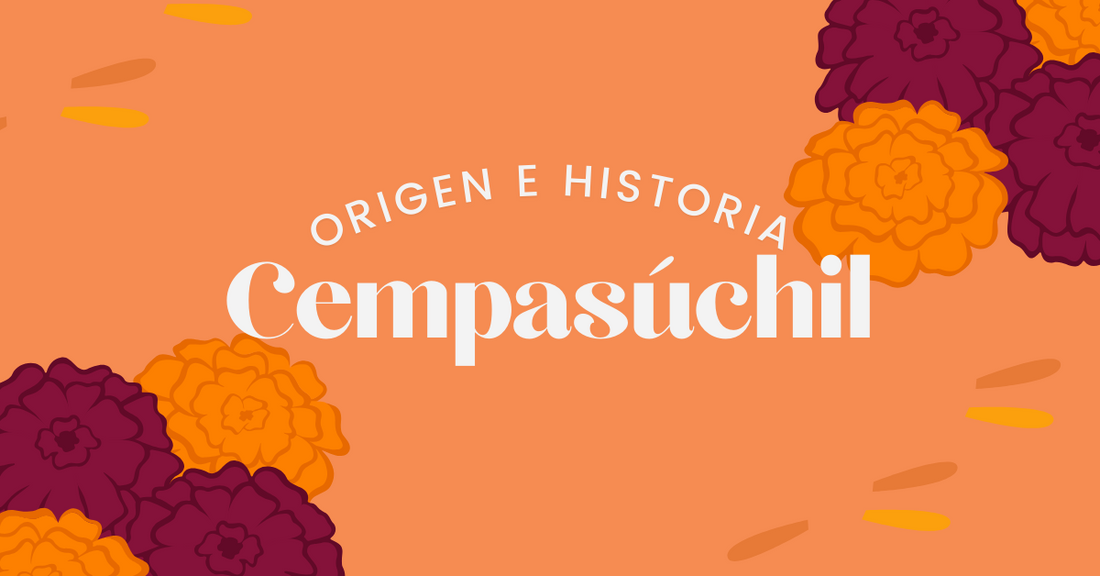The marigold (Tagetes erecta), also known as the "Flower of the Dead" or "Cempaxóchitl," is an emblematic flower in Mexican culture. Its history and meaning are deeply rooted in the traditions of the Day of the Dead, a celebration honoring loved ones who have passed away. Over the years, the marigold has played an important role in Mexican culture and history. In this article, we'll explore its origin and evolution over time.
Origin of the Cempasúchil:
The marigold is native to Mexico and Central America. Its name comes from the Nahuatl "cempohualxochitl," meaning "twenty flowers," in reference to the abundance of petals on each flower. This flower is believed to have been cultivated in Mexico for over 3,000 years. Ancient Mesoamerican peoples, such as the Aztecs, Mayans, and Purépecha, used the marigold in various ceremonies and rituals.

Importance in Pre-Hispanic Cultures:
In pre-Hispanic times, the marigold had a profound symbolic meaning. It was considered a sacred flower and was used to honor the gods and ancestors. Indigenous peoples believed the marigold had protective and purifying properties and used it in religious ceremonies and funeral rituals.
In Aztec culture, the marigold was associated with the goddess Mictecacihuatl, queen of the underworld. The Aztecs used it to decorate tombs and altars in honor of the deceased. They also believed that the flowers' scent guided the souls of the dead back to Earth during the Day of the Dead.
The Fusion of Traditions:
With the arrival of the Spanish conquistadors in the 16th century, indigenous traditions blended with Christian beliefs. This led to the fusion of the indigenous Day of the Dead festivities with All Saints' Day and All Souls' Day, Catholic holidays celebrated on November 1 and 2. This fusion gave rise to the holiday we know today as the Day of the Dead.
The marigold became an essential symbol of this celebration, as its fragrance and bright color were believed to attract and guide the souls of the deceased back to their loved ones on Earth. Day of the Dead offerings, known as "altars" or "ofrendas," are decorated with marigolds, candles, food, personal items, and portraits of the deceased.
Current Day of the Dead Use:
Today, the marigold continues to play a fundamental role in the Day of the Dead celebration in Mexico and in many Mexican communities abroad. During this holiday, the marigold is used in several ways:
-
Offering Altars: Day of the Dead altars are decorated with marigolds and other flowers. The scent and color of the flowers are believed to attract and guide the souls of the deceased back home.
-
Flower Petals: Cempasúchil petals are scattered in the shape of a path from the grave to the altar, so that souls can find their way.
-
Wreaths and Garlands: Cempasúchil flowers are used to make garlands and wreaths that are placed on graves and altars.
-
Art and Decor: Cempasúchil petals are used to create designs and floor coverings, known as "tapetes" or "flower rugs."
The Cempasúchil Today:
The marigold is not only important in the context of the Day of the Dead, but is also grown in gardens and public spaces in Mexico and other parts of the world due to its beauty and ease of care. In addition to its symbolic value, it is appreciated for its striking orange color and ability to bloom in the fall.
Conclusion:
The marigold is a flower that has played a fundamental role in the history and culture of Mexico. Its importance dates back to pre-Hispanic civilizations, where it was considered a sacred flower with protective and purifying properties. With the arrival of the Spanish conquistadors and the fusion of traditions, the marigold became a symbol of the Day of the Dead, one of Mexico's most iconic festivals. Today, the marigold remains a reminder of the connection between life and death, and its beauty and significance live on in celebrations and gardens around the world.







